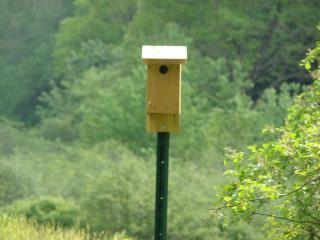Attracting Bluebirds and Setting Up Bluebird Houses

Since these birdhouses are made from cedar, they can withstand weather and don’t need to be finished. In fact, many finishes are actually toxic to young birds. If desired, you can finish the exterior only with linseed oil.
Ideally, birdhouses should be placed 4-5 feet off the ground. It is not recommended to place them on trees since this can allow a predator to reach the house. Try placing bluebird houses on t-poles, but a fence post will work, too.
Bluebirds are very territorial. If you plan to install more than one bluebird house, they should be at least 100 yards apart. However, by installing two houses back-to-back, a bluebird may occupy one house and a different type of bird (swallow or sparrow) may occupy the other. Bluebirds fight for territory with other bluebirds, but not with other types of birds.
When placing the houses, you should put them on the edge of open space along a tree line. Placing the house near a water source is also helpful. Be sure to face the house so the wind is less likely to blow into the entrance hole. Also, try to place the house so the sun will not shine directly into the entrance hole at sunrise or sunset.
The guidelines of the Massachusetts Audubon Society say that if another type of bird other than a bluebird moves into the nesting box, leave the birds alone.
Be sure to clean out your house each year in early spring (mid to late March). Tap the back of the box first (mice find the houses very nice and warm in the winter), then open the side and clean it out.

